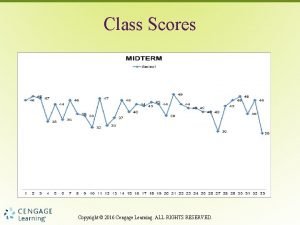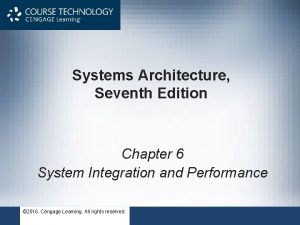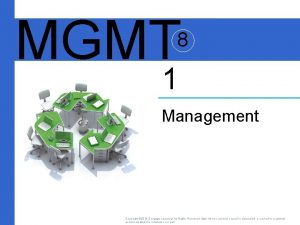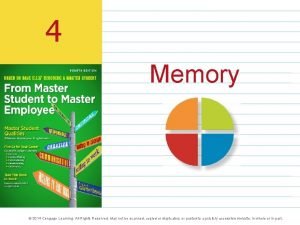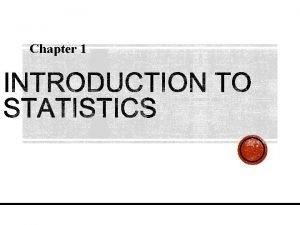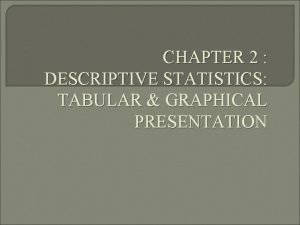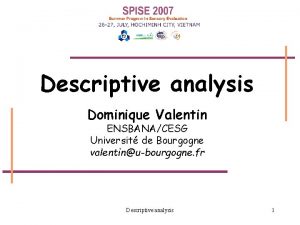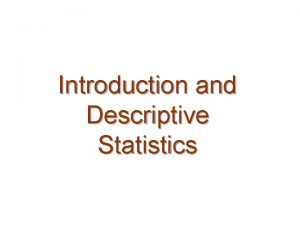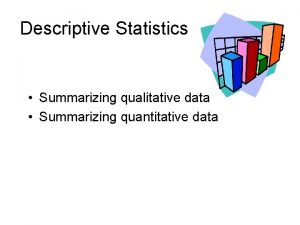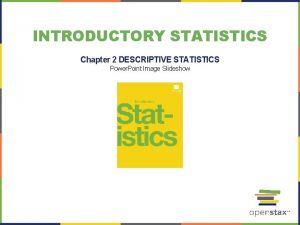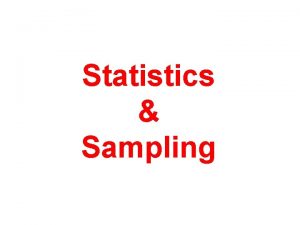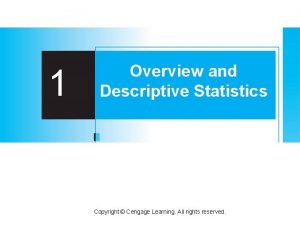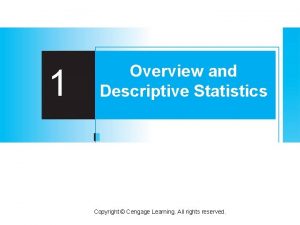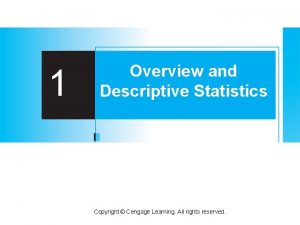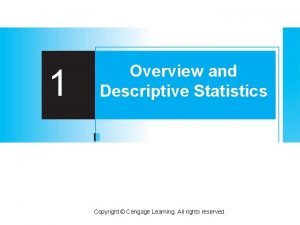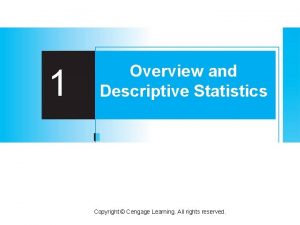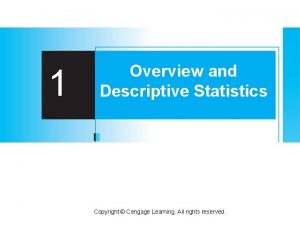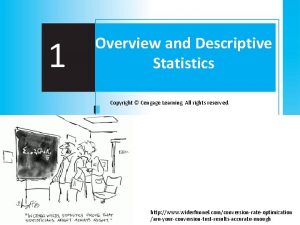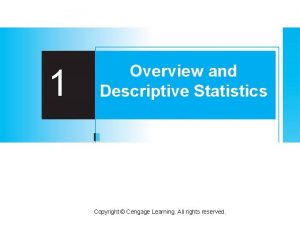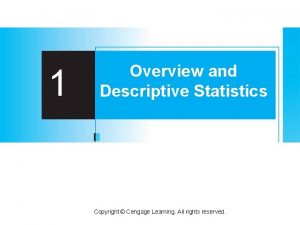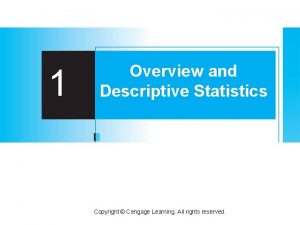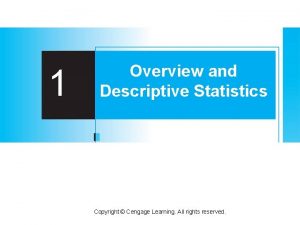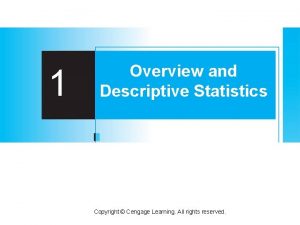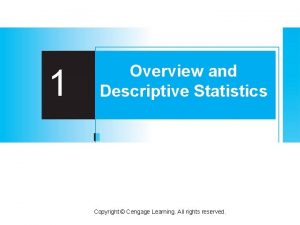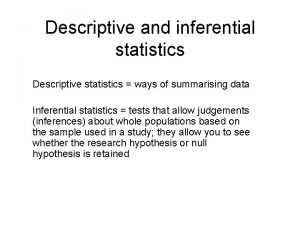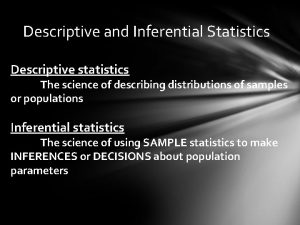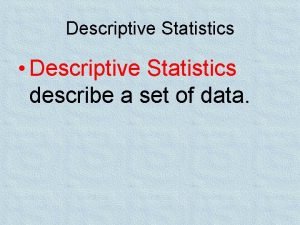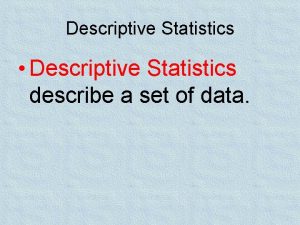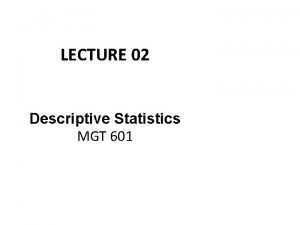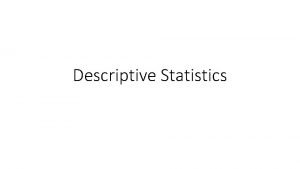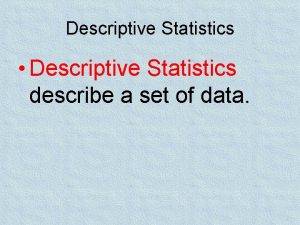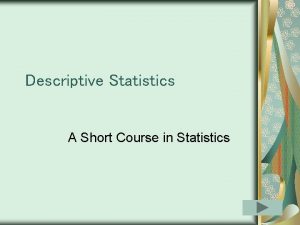1 Overview and Descriptive Statistics Copyright Cengage Learning














































- Slides: 46

1 Overview and Descriptive Statistics Copyright © Cengage Learning. All rights reserved.

1. 1 Populations, Samples, and Processes Copyright © Cengage Learning. All rights reserved.

Populations, Samples, and Processes Engineers and scientists are constantly exposed to collections of facts, or data, both in their professional capacities and in everyday activities. The discipline of statistics provides methods for organizing and summarizing data and for drawing conclusions based on information contained in the data. An investigation will typically focus on a well-defined collection of objects constituting a population of interest. In one study, the population might consist of all gelatin capsules of a particular type produced during a specified period. 3

Populations, Samples, and Processes Another investigation might involve the population consisting of all individuals who received a B. S. in engineering during the most recent academic year. When desired information is available for all objects in the population, we have what is called a census. Constraints on time, money, and other scarce resources usually make a census impractical or infeasible. Instead, a subset of the population—a sample—is selected in some prescribed manner. 4

Populations, Samples, and Processes A characteristic may be categorical, such as gender or type of malfunction, or it may be numerical in nature. In the former case, the value of the characteristic is a category (e. g. female or insufficient solder), whereas in the latter case, the value is a number (e. g. , age = 23 or diameter =. 502 cm). 5

Populations, Samples, and Processes A variable is any characteristic whose value may change from one object to another in the population. We shall initially denote variables by lowercase letters from the end of our alphabet. Examples include x = brand of calculator owned by a student y = number of visits to a particular Web site during a specified period z = braking distance of an automobile under specified conditions 6

Populations, Samples, and Processes Data results from making observations either on a single variable or simultaneously on two or more variables. A univariate data set consists of observations on a single variable. For example, we might determine the type of transmission, automatic (A) or manual (M), on each of ten automobiles recently purchased at a certain dealership, resulting in the categorical data set M A A A M A A 7

Populations, Samples, and Processes The following sample of pulse rates (beats per minute) for patients recently admitted to an adult intensive care unit is a numerical univariate data set: 88 80 71 103 154 132 67 110 60 105 We have bivariate data when observations are made on each of two variables. Our data set might consist of a (height, weight) pair for each basketball player on a team, with the first observation as (72, 168), the second as (75, 212), and so on. 8

Populations, Samples, and Processes If an engineer determines the value of both x = component lifetime and y = reason for component failure, the resulting data set is bivariate with one variable numerical and the other categorical. Multivariate data arises when observations are made on more than one variable (so bivariate is a special case of multivariate). For example, a research physician might determine the systolic blood pressure, diastolic blood pressure, and serum cholesterol level for each patient participating in a study. 9

Populations, Samples, and Processes Each observation would be a triple of numbers, such as (120, 80, 146). In many multivariate data sets, some variables are numerical and others are categorical. Thus the annual automobile issue of Consumer Reports gives values of such variables as type of vehicle (small, sporty, compact, mid-size, large), city fuel efficiency (mpg), highway fuel efficiency (mpg), drivetrain type (rear wheel, front wheel, four wheel), and so on. 10

Branches of Statistics 11

Branches of Statistics An investigator who has collected data may wish simply to summarize and describe important features of the data. This entails using methods from descriptive statistics. Some of these methods are graphical in nature; the construction of histograms, boxplots, and scatter plots are primary examples. Other descriptive methods involve calculation of numerical summary measures, such as means, standard deviations, and correlation coefficients. The wide availability of statistical computer software packages has made these tasks much easier to carry out than they used to be. 12

Branches of Statistics Computers are much more efficient than human beings at calculation and the creation of pictures (once they have received appropriate instructions from the user!). This means that the investigator doesn’t have to expend much effort on “grunt work” and will have more time to study the data and extract important messages. Throughout this book, we will present output from various packages such as Minitab, SAS, JMP, and R. The R software can be downloaded without charge from the site http: //www. r-project. org. 13

Example 1. 1 Charity is a big business in the United States. The Web site charitynavigator. com gives information on roughly 6000 charitable organizations, and there are many smaller charities that fly below the navigator’s radar screen. Some charities operate very efficiently, with fundraising and administrative expenses that are only a small percentage of total expenses, whereas others spend a high percentage of what they take in on such activities. 14

Example 1. 1 cont’d Here is data on fundraising expenses as a percentage of total expenditures for a random sample of 60 charities: 6. 1 12. 6 34. 7 1. 6 18. 8 2. 2 3. 0 2. 2 5. 6 3. 8 2. 2 3. 1 1. 3 1. 1 14. 1 4. 0 21. 0 6. 1 1. 3 20. 4 7. 5 3. 9 10. 1 8. 1 19. 5 5. 2 12. 0 15. 8 10. 4 5. 2 6. 4 10. 8 83. 1 3. 6 6. 2 6. 3 12. 7 1. 3 0. 8 8. 8 5. 1 3. 7 26. 3 6. 0 48. 0 8. 2 11. 7 7. 2 3. 9 15. 3 16. 6 8. 8 12. 0 4. 7 14. 7 6. 4 17. 0 2. 5 16. 2 15

Example 1. 1 cont’d Without any organization, it is difficult to get a sense of the data’s most prominent features—what a typical (i. e. representative) value might be, whether values are highly concentrated about a typical value or quite dispersed, whethere any gaps in the data, what fraction of the values are less than 20%, and so on. 16

Example 1. 1 cont’d Figure 1. 1 shows what is called a stem-and-leaf display as well as a histogram. A Minitab stem-and-leaf display (tenths digit truncated) and histogram for the charity fundraising percentage data Figure 1. 1 17

Some R code charity<-c(6. 1, 12. 6, 34. 7, 1. 6, 18. 8, 2. 2, 3. 0, 2. 2, 5. 6, 3. 8, 2. 2, 3. 1, 1. 3, 1. 1, 14. 1, 4. 0, 21. 0, 6. 1, 1. 3, 20. 4, 7. 5, 3. 9, 10. 1 , 8. 1, 19. 5 , 5. 2 , 12. 0, 15. 8, 10. 4 , 5. 2, 6. 4, 10. 8 , 83. 1 , 3. 6 , 6. 2 , 6. 3 , 16. 3, 12. 7, 1. 3, 0. 8, 8. 8 , 5. 1 , 3. 7 , 26. 3, 6. 0 , 48. 0 , 8. 2, 11. 7, 7. 2, 3. 9, 15. 3, 16. 6 , 8. 8 , 12. 0, 4. 7 , 14. 7 , 6. 4, 17. 0, 2. 5, 16. 2) hist(charity) stem(charity) 18

Branches of Statistics Clearly a substantial majority of the charities in the sample spend less than 20% on fundraising, and only a few percentages might be viewed as beyond the bounds of sensible practice. Having obtained a sample from a population, an investigator would frequently like to use sample information to draw some type of conclusion (make an inference of some sort) about the population. That is, the sample is a means to an end rather than an end in itself. Techniques for generalizing from a sample to a population are gathered within the branch of our discipline called inferential statistics. 19

The Scope of Modern Statistics 20

The Scope of Modern Statistics These days statistical methodology is employed by investigators in virtually all disciplines, including such areas as • molecular biology (analysis of microarray data) • ecology (describing quantitatively how individuals in various animal and plant populations are spatially distributed) • materials engineering (studying properties of various treatments to retard corrosion) 21

The Scope of Modern Statistics • marketing (developing market surveys and strategies for marketing new products) • public health (identifying sources of diseases and ways to treat them) • civil engineering (assessing the effects of stress on structural elements and the impacts of traffic flows on communities) As you progress through the book, you’ll encounter a wide spectrum of different scenarios in the examples and exercises that illustrate the application of techniques from probability and statistics. 22

The Scope of Modern Statistics Many of these scenarios involve data or other material extracted from articles in engineering and science journals. The methods presented herein have become established and trusted tools in the arsenal of those who work with data. Meanwhile, statisticians continue to develop new models for describing randomness, and uncertainty and new methodology for analyzing data. 23

The Scope of Modern Statistics As evidence of the continuing creative efforts in the statistical community, here are titles and capsule descriptions of some articles that have recently appeared in statistics journals (Journal of the American Statistical Association is abbreviated JASA, and AAS is short for the Annals of Applied Statistics, two of the many prominent journals in the discipline): 24

The Scope of Modern Statistics “How Many People Do You Know? Efficiently Estimating Personal Network Size” (JASA, 2010: 59– 70): How many of the N individuals at your college do you know? You could select a random sample of students from the population and use an estimate based on the fraction of people in this sample that you know. A “latent mixing model” was proposed that the authors asserted remedied deficiencies in previously used techniques. 25

The Scope of Modern Statistics • “Active Learning Through Sequential Design, with Applications to the Detection of Money Laundering” (JASA, 2009: 969– 981): Money laundering involves concealing the origin of funds obtained through illegal activities. The huge number of transactions occurring daily at financial institutions makes detection of money laundering difficult. The standard approach has been to extract various summary quantities from the transaction history and conduct a time-consuming investigation of suspicious activities. The article proposes a more efficient statistical method and illustrates its use in a case study. 26

The Scope of Modern Statistics • “Robust Internal Benchmarking and False Discovery Rates for Detecting Racial Bias in Police Stops” (JASA, 2009: 661– 668): Allegations of police actions that are attributable at least in part to racial bias have become a contentious issue in many communities. This article proposes a new method that is designed to reduce the risk of flagging a substantial number of “false positives” (individuals falsely identified as manifesting bias). 27

The Scope of Modern Statistics • “Records in Athletics Through Extreme Value Theory” (JASA, 2008: 1382– 1391): The focus here is on the modeling of extremes related to world records in athletics. The authors start by posing two questions: (1) What is the ultimate world record within a specific event (e. g. the high jump for women)? and (2) How “good” is the current world record, and how does the quality of current world records compare across different events? A total of 28 events (8 running, 3 throwing, and 3 jumping for both men and women) are considered. 28

The Scope of Modern Statistics For example, one conclusion is that only about 20 seconds can be shaved off the men’s marathon record, but that the current women’s marathon record is almost 5 minutes longer than what can ultimately be achieved. The methodology also has applications to such issues as ensuring airport runways are long enough and that dikes in Holland are high enough. 29

The Scope of Modern Statistics “Self-Exciting Hurdle Models for Terrorist Activity” (AAS, 2012: 106– 124): The authors developed a predictive model of terrorist activity by considering the daily number of terrorist attacks in Indonesia from 1994 through 2007. The model estimates the chance of future attacks as a function of the times since past attacks. The article provides an interpretation of various model characteristics and assesses its predictive performance. 30

The Scope of Modern Statistics • “Statistical Challenges in the Analysis of Cosmic Microwave Background Radiation” (AAS, 2009: 61– 95): The cosmic microwave background (CMB) is a significant source of information about the early history of the universe. Its radiation level is uniform, so extremely delicate instruments have been developed to measure fluctuations. The authors provide a review of statistical issues with CMB data analysis; they also give many examples of the application of statistical procedures to data obtained from a recent NASA satellite mission, the Wilkinson Microwave Anisotropy Probe. 31

Enumerative Versus Analytic Studies 32

Enumerative Versus Analytic Studies W. E. Deming, a very influential American statistician who was a moving force in Japan’s quality revolution during the 1950 s and 1960 s, introduced the distinction between enumerative studies and analytic studies. In the former, interest is focused on a finite, identifiable, unchanging collection of individuals or objects that make up a population. A sampling frame—that is, a listing of the individuals or objects to be sampled—is either available to an investigator or else can be constructed. 33

Enumerative Versus Analytic Studies For example, the frame might consist of all signatures on a petition to qualify a certain initiative for the ballot in an upcoming election; a sample is usually selected to ascertain whether the number of valid signatures exceeds a specified value. As another example, the frame may contain serial numbers of all furnaces manufactured by a particular company during a certain time period; a sample may be selected to infer something about the average lifetime of these units. 34

Enumerative Versus Analytic Studies The use of inferential methods to be developed in this book is reasonably noncontroversial in such settings (though statisticians may still argue over which particular methods should be used). An analytic study is broadly defined as one that is not enumerative in nature. Such studies are often carried out with the objective of improving a future product by taking action on a process of some sort (e. g. , recalibrating equipment or adjusting the level of some input such as the amount of a catalyst). 35

Collecting Data 36

Collecting Data Statistics deals not only with the organization and analysis of data once it has been collected but also with the development of techniques for collecting the data. If data is not properly collected, an investigator may not be able to answer the questions under consideration with a reasonable degree of confidence. One common problem is that the target population—the one about which conclusions are to be drawn—may be different from the population actually sampled. For example, advertisers would like various kinds of information about the television-viewing habits of potential customers. 37

Collecting Data The most systematic information of this sort comes from placing monitoring devices in a small number of homes across the United States. It has been conjectured that placement of such devices in and of itself alters viewing behavior, so that characteristics of the sample may be different from those of the target population. When data collection entails selecting individuals or objects from a frame, the simplest method for ensuring a representative selection is to take a simple random sample. This is one for which any particular subset of the specified size (e. g. , a sample of size 100) has the same chance of being selected. 38

Collecting Data For example, if the frame consists of 1, 000 serial numbers, the numbers 1, 2, . . . , up to 1, 000 could be placed on identical slips of paper. After placing these slips in a box and thoroughly mixing, slips could be drawn one by one until the requisite sample size has been obtained. Alternatively (and much to be preferred), a table of random numbers or a computer’s random number generator could be employed. 39

Collecting Data Sometimes alternative sampling methods can be used to make the selection process easier, to obtain extra information, or to increase the degree of confidence in conclusions. One such method, stratified sampling, entails separating the population units into nonoverlapping groups and taking a sample from each one. For example, a study of how physicians feel about the Affordable Care Act might proceed by stratifying according to specialty: select a sample of surgeons, another sample of radiologists, yet another sample of psychiatrists, and so on. 40

Collecting Data This would result in information separately from each specialty and ensure that no one specialty is over or underrepresented in the entire sample. Frequently a “convenience” sample is obtained by selecting individuals or objects without systematic randomization. As an example, a collection of bricks may be stacked in such a way that it is extremely difficult for those in the center to be selected. 41

Collecting Data If the bricks on the top and sides of the stack were somehow different from the others, resulting sample data would not be representative of the population. Often an investigator will assume that such a convenience sample approximates a random sample, in which case a statistician’s repertoire of inferential methods can be used; however, this is a judgment call. 42

Collecting Data Engineers and scientists often collect data by carrying out some sort of designed experiment. This may involve deciding how to allocate several different treatments (such as fertilizers or coatings for corrosion protection) to the various experimental units (plots of land or pieces of pipe). Alternatively, an investigator may systematically vary the levels or categories of certain factors (e. g. , pressure or type of insulating material) and observe the effect on some response variable (such as yield from a production process). 43

Example 1. 4 An article in the New York Times (Jan. 27, 1987) reported that heart attack risk could be reduced by taking aspirin. This conclusion was based on a designed experiment involving both a control group of individuals that took a placebo having the appearance of aspirin but known to be inert and a treatment group that took aspirin according to a specified regimen. Subjects were randomly assigned to the groups to protect against any biases and so that probability-based methods could be used to analyze the data. 44

Example 1. 4 cont’d Of the 11, 034 individuals in the control group, 189 subsequently experienced heart attacks, whereas only 104 of the 11, 037 in the aspirin group had a heart attack. The incidence rate of heart attacks in the treatment group was only about half that in the control group. One possible explanation for this result is chance variation —that aspirin really doesn’t have the desired effect and the observed difference is just typical variation in the same way that tossing two identical coins would usually produce different numbers of heads. 45

Example 1. 4 cont’d However, in this case, inferential methods suggest that chance variation by itself cannot adequately explain the magnitude of the observed difference. 46
 Cengage chapter 7
Cengage chapter 7 Delmar cengage learning medical terminology
Delmar cengage learning medical terminology Chapter 5 the cardiovascular system labeling exercises
Chapter 5 the cardiovascular system labeling exercises Cengage learning heart diagram
Cengage learning heart diagram South-western cengage learning
South-western cengage learning Chapter 13 medical math assignment sheet cengage learning
Chapter 13 medical math assignment sheet cengage learning 2009 delmar cengage learning
2009 delmar cengage learning Cengage learning heart diagram
Cengage learning heart diagram Medical terminology chapter 1 answer key
Medical terminology chapter 1 answer key Cengage learning australia
Cengage learning australia 2009 delmar cengage learning
2009 delmar cengage learning Whille
Whille Cengage learning
Cengage learning Wadsworth cengage learning
Wadsworth cengage learning Cengage learning
Cengage learning Cengage learning plant cell
Cengage learning plant cell Cengage learning
Cengage learning Cengage learning
Cengage learning Brooks cole cengage learning
Brooks cole cengage learning The human respiratory system chapter 7 handout
The human respiratory system chapter 7 handout 2014 cengage learning accounting answers
2014 cengage learning accounting answers Cengage learning
Cengage learning Cengage learning
Cengage learning Chapter 6 the skeletal system answer key
Chapter 6 the skeletal system answer key Cengage learning
Cengage learning Chapter 10 cultural diversity
Chapter 10 cultural diversity Consumer behavior cengage
Consumer behavior cengage 2012 cengage learning
2012 cengage learning Solomon four group design
Solomon four group design Cengage learning psychology
Cengage learning psychology Course technology cengage learning
Course technology cengage learning Course technology cengage learning
Course technology cengage learning Course technology cengage learning
Course technology cengage learning Course technology cengage learning
Course technology cengage learning 2016 cengage learning
2016 cengage learning Delmar cengage learning instructor resources
Delmar cengage learning instructor resources 2014 cengage learning
2014 cengage learning 2010 cengage learning
2010 cengage learning Branch of statistics
Branch of statistics Inferential statistics allow us to
Inferential statistics allow us to Tabular presentation of quantitative data
Tabular presentation of quantitative data What is the value of σx2 for the scores 1, 0, 2, 4?
What is the value of σx2 for the scores 1, 0, 2, 4? Example of descriptive statistics
Example of descriptive statistics Descriptive statistics ap psychology
Descriptive statistics ap psychology Introduction to descriptive statistics
Introduction to descriptive statistics Descriptive statistics for qualitative data
Descriptive statistics for qualitative data Introductory statistics chapter 2 answers
Introductory statistics chapter 2 answers






















